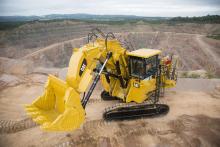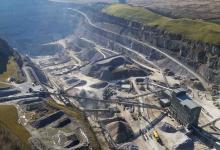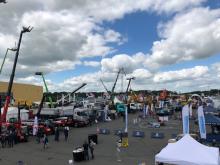
Compared to the bleak days of seven years ago, the economic outlook for the the UK and Ireland are now among the best in Europe.
Good news stories from companies in the aggregates, construction and related industries are not hard to find as new opportunities arise.
Businessman Craig Jackson has invested over €670,000 on new machines to enable the business to grow in a new direction, with a
In County Yorkshire, landscaping and building supplies company Mone Brothers is celebrating its golden anniversary.
“As the economy recovers we are seeing more and more commercial construction projects getting underway and a growing number of homeowners interested in developing their own properties,” says Phil Mone, who founded the business with brothers James and John Mone.
“We are very much a bellwether for both the construction and home improvement sectors and are hoping for another positive year of trading in 2015.”
Such optimism is not unfounded as organisations, including the British Chambers of Commerce (BCC), forecast increased growth. It recently upgraded its UK GDP growth forecast for the next two years, from 2.6% to 2.7% in 2015, and 2.4% to 2.6% in 2016, due to stronger than expected growth in household consumption and services. The latest forecast also makes the BCC’s first prediction for UK growth in 2017, at 2.6%.
In the UK, the
Seasonally adjusted results, which provide a consistent quarter-by-quarter comparison, indicated that crushed rock and sand and gravel sales volumes rose by 2.2% and 3.6% respectively compared to Q4 2014 and ready-mixed concrete and asphalt sales were 1.3% and 1.2% up. Annual sales of cement grew by 7.8% in 2014.
To put these improvements into a longer term perspective, the latest quarterly volumes for asphalt, aggregates and concrete remain 15%, 25% and 30% below the pre-recession peak respectively, so there remains significant scope for further improvements in minerals products and construction markets, particularly outside London and particularly in non-housing markets.
“Demand for our sector’s materials, which are critical to construction, has continued to grow in Q1 suggesting that construction activity remains buoyant,” says Nigel Jackson, Chief Executive MPA, which covers 100% of GB cement production; 90% of aggregates production; 95% of asphalt, and over 70% of ready-mixed concrete and precast concrete production. Each year the industry supplies £9 billion (€12 billion) of materials and services to the £120 billion (€162.5 billion) construction and other sectors.
“We believe that recent preliminary ONS [Office for National Statistics] construction data may be underestimating actual levels of activity and await later revisions to confirm the true picture. However, the official data do highlight that construction activity is essential to a continuing economic recovery and a new government must ensure that uncertainty is minimised to boost confidence and to encourage sustained public and private investment in construction following the [recent general] election.”
According to data from BDS Marketing, which compiles sectoral market surveys and reports, around 160 million tonnes of aggregates were extracted in Great Britain in 2014, and current forecasts suggest that “the market is in for a period of steady growth.”
A recent BDS report found that
Since the BDS report, international building materials group
Peter Tom, chairman of
Meanwhile, for 2015,
“As with the market for the construction equipment industry as a whole, the UK and Irish screening and crushing market has been influenced by a variety of factors that have affected demand,” says Sandvik Construction.
“These include problems in the Eurozone, conflicting political messages and varying demands for aggregates. However, this demand is now increasing, with increasing investment in infrastructure projects as well as investment in new equipment becoming more prevalent. In effect the prognosis is good.
“In the UK and Ireland we are seeing signs of demand increasing as equipment is being upgraded to reflect changing customer requirements with greater emphasis on productivity, EHS, efficiency and fuel economy.”
David Munns, director of sales and marketing at Volvo Construction Equipment GB, says: “The mineral extraction industry has clearly suffered more than most since the financial crash in 2007. This year we have seen a marked improvement in activity with our customers, no doubt fuelled by the increase in construction-related projects, particularly housebuilding and infrastructure.
“The extraction industry segments account for approximately a third of our sales in wheeled loaders, a significant proportion of sales of larger excavators and articulated haulers.
“Our sales volume for all products has increased dramatically and we are nearly back to pre-2007 levels. We have successfully launched a record number of new models over the last two years and they have enabled us to maintain a steady growth in our market share. In particular, our new H-Series wheeled loaders have been incredibly well received.
“The mineral extraction segment will always be significant for us.”
Other companies, including
A recovering Irish construction industry was the backdrop to Ireland’s largest construction and quarrying machinery show, CQMS ’15, held recently in County Offaly, when over €50 million of construction and quarrying equipment was showcased.
The Ulster Bank Construction Purchasing Managers’ Index, a seasonally adjusted index designed to track changes in total construction activity, points to higher levels of construction activity expected in 2015 following recent strong growth levels; construction companies taking on extra staff at rapid rate with 10,000 new people employed in 2014, and overall optimism among Irish construction companies for a positive 2015.
There is also a strong demand for new technologies in construction equipment, and indications are that 2015 will see economic growth of between 4%-6%.
“As construction companies start to shake off the financial limitations caused by the downturn, the increased activity and improved cash flows will lead to a stronger demand for new construction equipment and machinery,” says Tom Parlon director general of the Construction Industry Federation (CIF).
“For that reason CQMS ‘15 is a very timely event, providing contractors of all sizes with the opportunity to see the latest advancements in construction equipment before they make their purchases.”
Brian Coogan, event organiser and publisher of Machinery Movers Magazine, says: “There has not been much purchasing power in the market in recent years. However, now we are beginning to see some green shoots emerging within the construction industry. All indicators point to a growing market and this naturally leads to a requirement for new machinery.
“There is little to no second-hand machinery left on the Irish market, and therefore now is the time for the industry to upgrade its fleet with the new technology that is currently available. The Irish market is ready for work after seven years of recession. Companies are now in a position where they need to purchase new equipment.”
BDS Marketing says that housing markets are increasing in Ireland, both north and south of the border.
In Northern Ireland, 5,170 new houses were started in 2013-14, the lowest for many years and compared with 15,000 in 2006.
In the Irish Republic, the 10,500 house completions in 2014 was 35% higher than in 2013, and although the highest level of completions since 2010, the 2014 figure compared with the 88,000 in 2006. Markets are continuing to improve in 2015.







